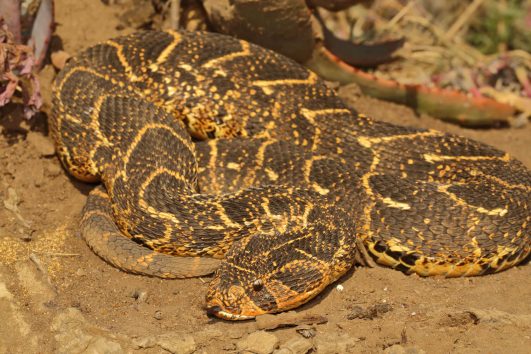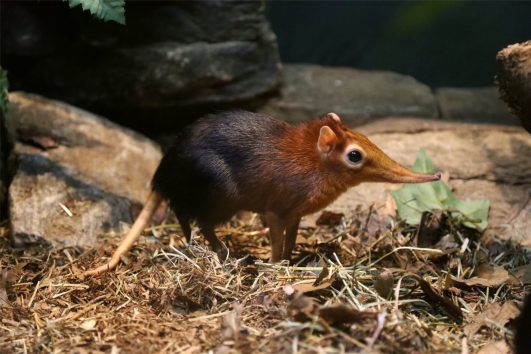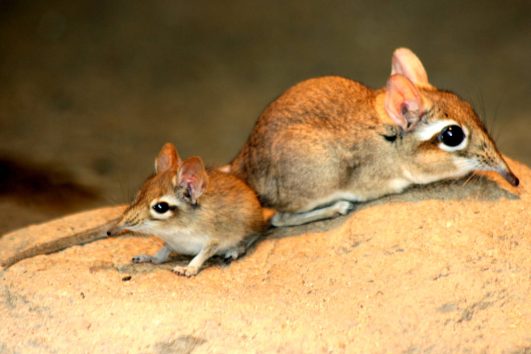Harvey’s duiker (Cephalophus harveyi) is a fascinating antelope species that inhabits the dense forests and woodlands of West Africa. Named after its discoverer, Dr. W.C.H. Harvey, this elusive and captivating duiker holds a unique place in the region’s biodiversity.
Harvey’s duiker is named after British naturalist Arthur Harvey and is known for its beautiful coat and striking facial markings. It is a shy and elusive forest-dwelling antelope that is well-adapted to its dense habitat. Like other duiker species, Harvey’s duikers play a role in seed dispersal and contribute to the ecological balance of their ecosystem. However, habitat loss and hunting pose threats to their population, emphasizing the importance of conservation efforts to protect this species in the wild.
Harveys Duiker: Species Profile
COMMON NAME: Harvey’s Duiker
SWAHILI NAME: Funo wa Harvey
SCIENTIFIC NAME: Cephalophus harveyi
TYPE: Mammal
FOOD: Harvey’s duikers are herbivores, primarily feeding on a variety of plant materials such as leaves, fruits, flowers, and grasses. They may also browse on twigs and bark.
HABITAT: Harvey’s duikers are found in the forests and woodlands of Central Africa, including countries like Cameroon, Equatorial Guinea, and Gabon. They prefer dense vegetation and are often found in areas with thick undergrowth and canopy cover.
SIZE: Harvey’s duikers are medium-sized antelopes, with adults measuring around 60-90 centimeters (24-35 inches) in height at the shoulder. They have a compact body with slender legs and weigh approximately 15-25 kilograms (33-55 pounds).
AVERAGE LIFE SPAN IN THE NATURAL HABITAT: The average lifespan of Harvey’s duikers in the wild is not well-documented, but it is estimated to be around 10-12 years.
ACTIVE: Harvey’s duikers are primarily crepuscular and nocturnal, being most active during the twilight hours of dawn and dusk. They are solitary animals and are known for their secretive behavior, often hiding in thick vegetation and using their excellent camouflage to avoid predators.
GESTATION PERIOD: The gestation period of Harvey’s duikers lasts for approximately 7-8 months. After this period, a single calf is born, which remains hidden in vegetation and relies on its mother for protection and nourishment.
WEIGHT: Adult Harvey’s duikers weigh between 15-25 kilograms (33-55 pounds), with males being slightly larger than females.
SIZE COMPARISON TO A 6-FT MAN: Harvey’s duikers are smaller in size compared to a 6-ft man, standing around 60-90 centimeters (24-35 inches) tall at the shoulder.
Distinctive Physical Features:
It is worth noting that individual variations in coat color and markings can occur, and the appearance of Harvey’s Duiker may differ slightly among different subspecies and populations across its range. It possesses several distinct physical characteristics that set it apart from other antelope species. Here are the notable features of Harvey’s Duiker’s appearance:
- Size and Build: Harvey’s Duiker is a relatively small antelope, with males and females similar in size. They typically stand about 60 to 70 centimeters (24 to 28 inches) tall at the shoulder and weigh between 20 to 30 kilograms (44 to 66 pounds). Their body is compact and muscular, adapted for maneuvering through dense vegetation.
- Coat Color: The duiker’s coat is short, dense, and coarse. The coloration can vary depending on the individual and subspecies, but typically ranges from reddish-brown to dark brown. Some individuals may exhibit a grizzled appearance due to the presence of lighter-colored hairs mixed in with the darker coat.
- Facial Markings: Harvey’s Duiker has distinct facial markings that contribute to its unique appearance. It features prominent white or pale markings around the eyes, forming a spectacle-like pattern. The face is also adorned with a white chin and throat patch.
- Horns: Both males and females of Harvey’s Duiker possess short, slender horns. The horns are straight and slightly curved backward, growing vertically from the top of the head. They are typically around 7 to 12 centimeters (2.8 to 4.7 inches) in length and are primarily used for defense and territorial disputes.
- Scent Glands: Like many other duiker species, Harvey’s Duiker possesses preorbital glands located in front of each eye. These glands secrete a strong-smelling substance used for scent marking and communication with other individuals.
- Body Shape: Harvey’s Duiker has a compact and sturdy body, with a slightly arched back and strong legs. This body shape enables it to navigate through dense vegetation with agility and ease.
Behavior and Adaptations:
Understanding the behavior of Harvey’s Duiker enhances our appreciation of this remarkable forest antelope and highlights the need for conservation efforts to protect their natural habitat. Here are some insights into the behavior and lifestyle of Harvey’s Duiker:
- Nocturnal Nature: Harvey’s Duiker is primarily nocturnal, meaning it is most active during the night. This behavior helps it avoid predators and navigate through the dense forests where it resides. During the day, it seeks shelter and rests in dense vegetation or concealed areas to minimize the risk of predation.
- Solitary Life: Harvey’s Duiker is a solitary animal, preferring to live and forage alone. It establishes and defends its territory, marking boundaries with scent markings from its preorbital glands. Male duikers are particularly territorial and may engage in territorial displays to ward off intruders.
- Secretive and Shy: Due to their preference for dense forest habitats, Harvey’s Duikers are known for their secretive and shy behavior. They have a remarkable ability to remain concealed within the foliage, making them difficult to spot in their natural environment. Their excellent camouflage and cautious approach help them evade predators and maintain their safety.
- Diet and Foraging: Harvey’s Duiker is primarily herbivorous, feeding on a variety of plant materials found in the forest. Their diet consists of leaves, fruits, buds, shoots, and flowers. They are known to be selective feeders, carefully choosing their food sources based on availability and nutritional value.
- Vocalizations: While generally quiet animals, Harvey’s Duikers can produce a range of vocalizations for communication. These include soft whistles, grunts, and snorts. These vocalizations serve as a means of contact between individuals, especially during the breeding season.
- Grooming Behavior: Harvey’s Duiker engages in grooming behavior, using its prehensile tongue to clean its fur. Grooming not only helps them maintain their coat but also plays a role in social bonding and scent distribution.
- Predator Avoidance: Like many other forest-dwelling antelope species, Harvey’s Duiker has evolved various strategies to avoid predation. Their small size, agility, and cryptic coloration make them difficult to detect by predators such as leopards, African golden cats, and pythons. They rely on their keen senses, including sharp hearing and a strong sense of smell, to detect and evade potential threats.
Conservation Status:
Harvey’s duiker is currently listed as “Vulnerable” on the International Union for Conservation of Nature (IUCN) Red List. The species faces several threats, including habitat loss due to deforestation, illegal hunting for bushmeat, and the expansion of agriculture. Urgent conservation measures are necessary to protect its woodland habitats, enforce hunting regulations, and raise awareness about the importance of preserving this unique antelope species.
Cephalophus harveyi
Cephalophus harveyi (Harvey’s duiker), with its distinct features and elusive nature, adds to the biodiversity and ecological balance of West African forests. By prioritizing its conservation and implementing sustainable land-use practices, we can ensure the long-term survival of Harvey’s duiker and contribute to the preservation of the precious ecosystems it calls home.
Harvey’s Duikers: Remarkable Adaptations
Harvey’s Duiker (Cephalophus harveyi) has developed several remarkable adaptations that enable it to thrive in its forest habitat. These adaptations contribute to its survival, foraging efficiency, and ability to evade predators. Here are the notable adaptations of Harvey’s Duiker:
- Camouflage: The coat coloration of Harvey’s Duiker serves as effective camouflage in the dense forest environment. Its reddish-brown to dark brown coat blends with the foliage, allowing it to remain inconspicuous and well-hidden from predators and potential threats.
- Compact Body Size: Harvey’s Duiker possesses a compact body size, which is advantageous for maneuvering through dense vegetation. Its small stature allows it to navigate narrow pathways and underbrush with ease, granting access to food sources and offering protection in thick vegetation.
- Agile and Nimble: The duiker’s nimble and agile nature is a crucial adaptation for navigating the complex forest terrain. It has well-developed leg muscles that provide strength and flexibility, enabling it to leap over obstacles, change direction quickly, and maintain balance on uneven surfaces.
- Scent Glands: Harvey’s Duiker possesses preorbital glands located in front of each eye. These glands secrete a strong-smelling substance used for scent marking and communication. By leaving scent marks on vegetation or objects within their territory, duikers can convey information about their presence and territorial boundaries to other individuals.
- Keen Senses: Harvey’s Duikers have well-developed senses that aid their survival in the forest. They have excellent hearing, allowing them to detect potential threats or the movements of other animals. Their large eyes provide good vision in low-light conditions, aiding their nocturnal lifestyle.
- Selective Feeding Habits: These duikers have adapted to their forest habitat by being selective feeders. They have specialized dentition and a complex digestive system that enables them to efficiently extract nutrients from their plant-based diet. Their selective feeding behavior ensures they consume the most nutritious parts of plants while avoiding potentially harmful or low-quality vegetation.
- Alertness and Wariness: Harvey’s Duikers are highly alert and cautious animals. Their survival depends on their ability to remain vigilant and respond quickly to potential dangers. They rely on their sharp senses, such as sight and hearing, to detect predators or other threats, allowing them to take evasive action and escape.
These adaptations showcase the remarkable evolutionary traits of Harvey’s Duiker, allowing it to thrive in the challenging and competitive forest environment.
Where to Spot Harvey’s Duikers in Tanzania:
If you’re an avid wildlife enthusiast visiting Tanzania, you may be eager to catch a glimpse of the elusive Harvey’s Duiker (Cephalophus harveyi). These fascinating forest antelopes can be found in specific regions within Tanzania. Here are some places where you have a chance to spot Harvey’s Duikers:
- Udzungwa Mountains National Park: Located in the southern part of Tanzania, Udzungwa Mountains National Park is a haven for biodiversity, including a population of Harvey’s Duikers. The park’s pristine montane forests provide a suitable habitat for these shy antelopes. Exploring the park’s hiking trails, such as the Sanje Waterfalls trail, may increase your chances of encountering these elusive creatures.
- Rubondo Island National Park: Situated in Lake Victoria, Rubondo Island National Park offers a unique opportunity to observe Harvey’s Duikers in a different ecosystem. This park is characterized by dense forests and diverse wildlife, making it a potential location for spotting these antelopes during guided walks or game drives.
- Mahale Mountains National Park: Nestled along the shores of Lake Tanganyika, Mahale Mountains National Park is renowned for its population of chimpanzees. However, the park also provides a suitable habitat for Harvey’s Duikers. Exploring the park’s lush forests while on a chimpanzee trekking expedition might reward you with a sighting of these elusive antelopes.
- Kitulo National Park: Known as the “Serengeti of Flowers,” Kitulo National Park is situated in the southern highlands of Tanzania. Although primarily known for its stunning floral displays, the park is also home to various wildlife species, including Harvey’s Duikers. While exploring the park’s walking trails, keep a keen eye out for these forest-dwelling antelopes.
It’s important to note that Harvey’s Duikers are known for their secretive behavior and preference for dense forest habitats. Therefore, spotting them in the wild can be a challenging task. It is recommended to engage the services of experienced local guides or join organized wildlife tours to enhance your chances of encountering these elusive creatures.
Remember, the opportunity to see Harvey’s Duikers in their natural habitat is a privilege, so be respectful of the environment and follow ethical wildlife viewing practices.
Harvey’s Duiker Safari Tips:
Embarking on a safari to observe Harvey’s Duikers (Cephalophus harveyi) in their natural habitat can be an exciting and rewarding experience. These elusive forest antelopes require a patient and thoughtful approach to maximize your chances of spotting them. Here are some safari tips to enhance your Harvey’s Duiker encounter:
- Choose the Right Safari Destination: Selecting the right safari destination is crucial for increasing your chances of encountering Harvey’s Duikers. Opt for national parks or conservation areas known to have populations of these antelopes, such as Udzungwa Mountains National Park, Rubondo Island National Park, Mahale Mountains National Park, or Kitulo National Park in Tanzania.
- Engage Experienced Guides: Experienced guides with knowledge of local wildlife behavior and habitat preferences can greatly enhance your duiker safari. Their expertise and familiarity with the specific areas where duikers are known to inhabit can significantly improve your chances of locating and observing these elusive creatures.
- Early Morning and Late Afternoon: Harvey’s Duikers are crepuscular animals, meaning they are most active during the early morning and late afternoon hours. Plan your safari activities accordingly, as these are the optimal times to increase your chances of encountering duikers in their natural habitat. Early morning game drives or guided walks can offer the best opportunities for sighting duikers.
- Practice Silence and Patience: Duikers are known for their skittish behavior and sensitivity to noise. When on a duiker safari, maintain a quiet and respectful demeanor. Minimize unnecessary movement, refrain from loud conversations, and listen attentively for any signs of duiker activity. Patience is key, as duikers may take time to emerge from their hiding spots and become visible.
- Explore Forested Areas: Harvey’s Duikers are primarily found in dense forest habitats. When planning your safari, prioritize visiting areas with ample forest cover, as this is where duikers are most likely to be found. Opt for walking safaris or off-road game drives that allow access to the interior of the forest, increasing your chances of encountering duikers.
- Be Mindful of Fragile Ecosystems: While on your duiker safari, respect the natural environment and adhere to responsible wildlife viewing practices. Follow park regulations, stay on designated paths or roads, and avoid disturbing vegetation or wildlife habitats. By being mindful of the ecosystem, you contribute to the preservation of duiker populations and their habitats.
- Use Binoculars and Cameras: Duikers are masters of camouflage and can blend seamlessly into their surroundings. Carry binoculars or a camera with a telephoto lens to aid in spotting and observing duikers from a distance. These optical tools can enhance your safari experience and allow for a closer look at these fascinating antelopes.
Remember, wildlife encounters are unpredictable, and there is no guarantee of seeing Harvey’s Duikers during a safari. However, by following these tips and maintaining a respectful and patient approach, you increase your chances of a successful duiker sighting and a memorable wildlife experience.
Frequently Asked Questions about Harvey’s Duikers
Q1: What are Harvey’s Duikers?
A1: Harvey’s Duikers (Cephalophus harveyi) are small to medium-sized antelopes found in the forests of East Africa, including Tanzania. They are known for their shy and elusive nature.
Q2: How big do Harvey’s Duikers grow?
A2: Adult Harvey’s Duikers typically reach a shoulder height of around 50-60 centimeters (20-24 inches) and weigh between 15 and 25 kilograms (33-55 pounds).
Q3: What is the typical habitat of Harvey’s Duikers?
A3: Harvey’s Duikers primarily inhabit dense forests, including lowland rainforests, montane forests, and gallery forests. They rely on thick vegetation for cover and are well adapted to life in these habitats.
Q4: Are Harvey’s Duikers solitary or social animals?
A4: Harvey’s Duikers are primarily solitary animals, although they may occasionally form small groups consisting of a male, female, and their offspring. They mark their territories with scent glands and communicate through vocalizations.
Q5: What do Harvey’s Duikers eat?
A5: Harvey’s Duikers are herbivores and primarily feed on a variety of leaves, shoots, fruits, and flowers. They have a selective feeding behavior and will browse on preferred plant species.
Q6: Are Harvey’s Duikers endangered?
A6: The conservation status of Harvey’s Duikers is currently categorized as “Near Threatened” by the International Union for Conservation of Nature (IUCN). Habitat loss and hunting pose significant threats to their populations.
Q7: How can I spot a Harvey’s Duiker in the wild?
A7: Spotting Harvey’s Duikers requires patience and a keen eye. Look for signs such as tracks, droppings, or browse marks on vegetation. Experienced guides and trackers can help locate duikers and increase your chances of a sighting.
Q8: Are Harvey’s Duikers active during the day or night?
A8: Harvey’s Duikers are primarily active during the early morning and late afternoon, making these the best times to observe them. They are most active when there is reduced human activity and the forest is relatively quiet.
Q9: Can I see Harvey’s Duikers on a safari in Tanzania?
A9: Yes, Tanzania is one of the countries where Harvey’s Duikers can be found. National parks and protected areas such as Udzungwa Mountains National Park and Kitulo National Park offer opportunities to spot these elusive antelopes.
Q10: What other wildlife can I expect to see while searching for Harvey’s Duikers in Tanzania?
A10: While searching for Harvey’s Duikers, you may also encounter other fascinating wildlife species such as primates, birds, other antelope species, and a diverse range of flora and fauna that inhabit the forests of Tanzania.
Remember, wildlife encounters are unpredictable, and the sighting of Harvey’s Duikers cannot be guaranteed. However, with proper planning, patience, and the assistance of knowledgeable guides, you can increase your chances of a rewarding duiker safari experience.




Tour Reviews
There are no reviews yet.
Leave a Review